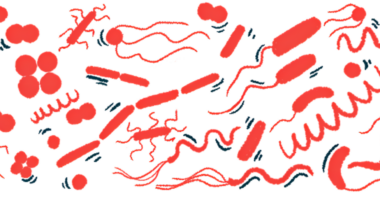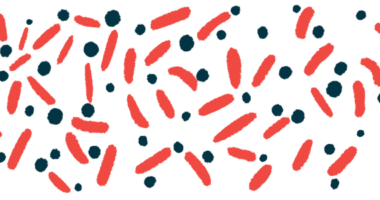Alpha-synuclein clumps may travel via vagus nerve from gut to brain
Mouse study suggests nerve carries toxic protein from 'gut cells to hindbrain'

Alpha-synuclein — the protein that forms toxic clumps in the brains of people with Parkinson’s disease — may travel from enteroendocrine cells lining the gut to the brain through the vagus nerve, according to a study aiming to build on previous evidence of a gut-brain axis in Parkinson’s.
Enteroendocrine cells sense nutrients in food as well as dangers such as toxins, research shows, and they respond by releasing hormones and other substances that act locally on vagus nerve endings or further away after passing into the bloodstream.
The vagus nerve, the body’s longest nerve, runs from the brain through the neck and into the abdomen. It’s part of the autonomic nervous system, which controls involuntary bodily functions like heart rate, digestion, and respiratory rate.
“It’s when alpha-synuclein proteins become corrupted that this transport system becomes an issue,” Rodger Liddle, MD, the study’s lead author and a professor of medicine at Duke University School of Medicine in North Carolina, said in a Duke Health news release.
Earlier work found no toxic spread after surgically cutting vagus nerve of mice
“If they are corrupted in the gut and are then able to spread to the brain, they could form clumps known as Lewy bodies, which are the hallmark of Parkinson’s disease and other forms of dementia,” said Liddle, who heads a lab at the Duke school focused on enteroendocrine cell biology.
In cell and mouse studies, Liddle and his team saw that enteroendocrine cells carry alpha-synuclein from mucosal cells of the gut to the brainstem via the vagus nerve.
They were able to stop the toxic clumps of this protein from reaching the brains of mice by surgically cutting their vagus nerve.
Growing evidence supports a role of the gut-brain axis in how Parkinson’s develops and progresses. Prior research also suggests that ongoing inflammation or protein clumping in the digestive tract triggers similar events in the brain, possibly traveling on vagus nerve endings to accumulate in the brain.
How and where in the gut alpha-synuclein becomes misshapen (misfolded) and begins to clump into toxic clusters that can spread and grow to form long, thread-like fibrils (fibers), however, is unclear.
“We hypothesize that something in the gut is corrupting alpha-synuclein, causing it to misfold,” Liddle said. “Whether this is toxicants or some other exposure, we don’t know.”
Researchers focused on enteroendocrine cells lining the small intestine. These “elongated or flask-shaped cells” contain large amounts of alpha-synuclein, they noted.
The study detailing their work, “Gut mucosal cells transfer alpha-synuclein to the vagus nerve,” was published in the journal JCI Insight.
On organoids, toxic protein seen to quickly form ‘patches’ on nerve cells
Initial work was in a mouse model engineered to carry a human SNCA gene, which provides instructions for producing human alpha-synuclein, and a mutation called A53T that is known to cause early-onset familial Parkinson’s. These mice had clusters of toxic alpha-synuclein in their enteroendocrine cells.
When the team grew intestinal organoids — small lab-made, organ-like structures — from the gut of these mice together with mouse nerve cells that do not produce alpha-synuclein, the protein readily spread to the nerve cells, where it “presented as patches,” the researchers reported.
They also used mice genetically engineered to produce human alpha-synuclein exclusively in gut-lining cells upon injection of tamoxifen, a chemical. Three months later, alpha-synuclein production was evident in the mice’s intestines and fibrils were present along their vagus nerve.
“Our detection of [alpha]-synuclein seeding activity in the vagus in the … mice is consistent with reports of neuropathology in the sensory branch of the vagus nerve in patients with [Parkinson’s disease],” the researchers wrote.
In mice not given tamoxifen or whose vagus nerve had been surgically cut before initiating alpha-synuclein production, no protein fibrils were found in the animals’ hindbrain, located at the base of the brain.
“These results suggest that [disease causing] [alpha]-synuclein fibril activity likely spreads from the gut cells … to the hindbrain via the vagus nerve,” the researchers wrote.
“Overall, these findings highlight a potential non-neuronal source of fibrillar [alpha]-synuclein protein that might arise in gut mucosal cells,” they concluded, urging more research in this area.







